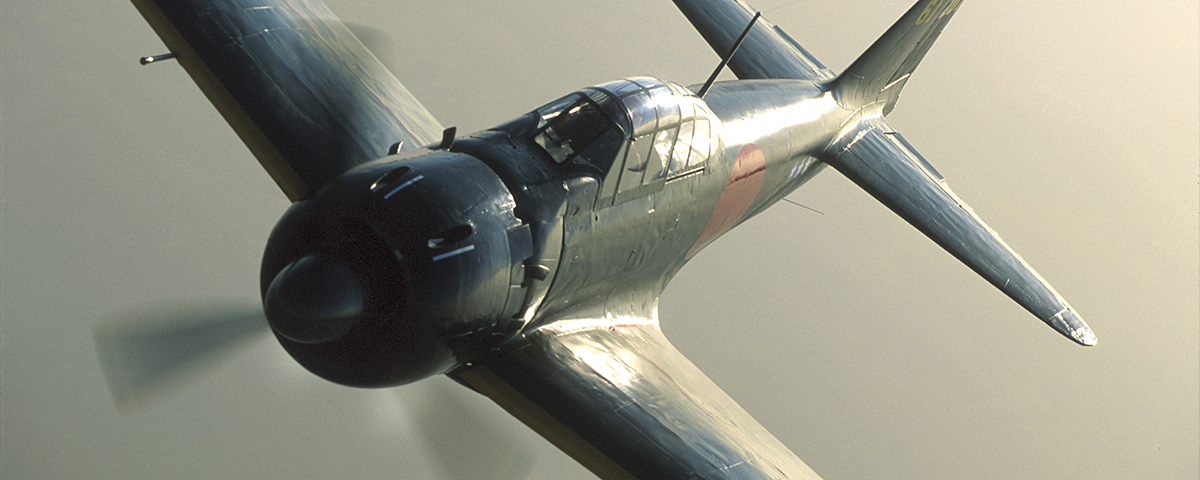Has there ever been a warplane as mythic as the Mitsubishi Zero? Legend, mystery, racism and rumor conflated to create an unbeatable fighter flown by samurai-tough pilots. The Zero was said to have awesome performance, superb maneuverability and combat characteristics an order of magnitude ahead of anything else in the sky.
Or, if you believed a different set of legends, mysteries, racism and rumor, it was a flimsy, beer-can tinderbox that brazenly aped Western designs and was flown by short, bandy-legged Asians who wore Coke-bottle-bottom glasses and fled whenever the U.S. Navy opened a can of Grumman whup-ass.
The truth—and how many times have you heard this?—lies somewhere in the middle.
The oft-forgotten fact is that the Zero’s effective combat career was measured in months. Not counting its earliest sucker-punch missions over China, when the best-trained fighter pilots in the world swatted down scores of ill-flown Polikarpov biplanes and open-cockpit monoplanes, the Zero reigned supreme in the Pacific War only from the day of the Pearl Harbor attack until American pilots learned tactics that allowed even pudgy F4F Wildcats to level the aerial playing field during the Guadalcanal campaign in the summer and fall of 1942. When the second generation of U.S. World War II fighters—P-38, F4U and F6F—arrived beginning in early 1943, the Zero was finished as an effective fighter. In January 1944, a single Marine F4U pilot, 1st Lt. Robert Hanson, shot down 20 Zeros in 17 days.
The Zero soldiered on until the end of the war, of course—many self-immolating as kamikazes—but only because the Japanese had nothing to replace it, and the Zero often was simply cannon fodder. The June 1944 Marianas Turkey Shoot is the most notorious example of such inequity. Not that the Zero wasn’t still dangerous even in 1945, especially if an aviator was cocky enough to try to dogfight one of the few remaining experienced Zero pilots. Nobody ever built a fighter that could outmaneuver it, and the fact that Grumman developed the F8F Bearcat as a Zero-beater—a task that it was just a bit too late to fulfill—shows that the Zero was never entirely disdained.
The Japanese had counted on a short, brutal war—not to annex America as an enormous sushi-loving colony, but to force the U.S. to the negotiating table in order to establish an unfettered area of Japanese exploitation in Southeast Asia and the Pacific. So Japan had done little to prepare for a protracted conflict. Zero pilots were superbly trained, but only hundreds at a time, then a few thousand a year while the U.S. was turning tens of thousands of college grads into pilots; the great majority of Japanese pilots were the equivalent of our NCOs. Nor was the production of a Zero successor given high priority. Much like the German high command initially assumed the Me-109 would suffice for the duration of the war and that it didn’t need to engineer a successor, the Japanese waited too long to develop and produce the Shiden, Raiden and Reppu. Or perhaps they should have developed just one of them. It didn’t help that Japan, a small island nation with limited engineering and manufacturing manpower, spent its time dithering over the development of more than 90 major combat types as well as several dozen lesser models. By the time they did get serious, raw materials were lacking and the country’s skilled airframe-and-engine workforce had fled the manufacturing centers, bombed out of their homes.
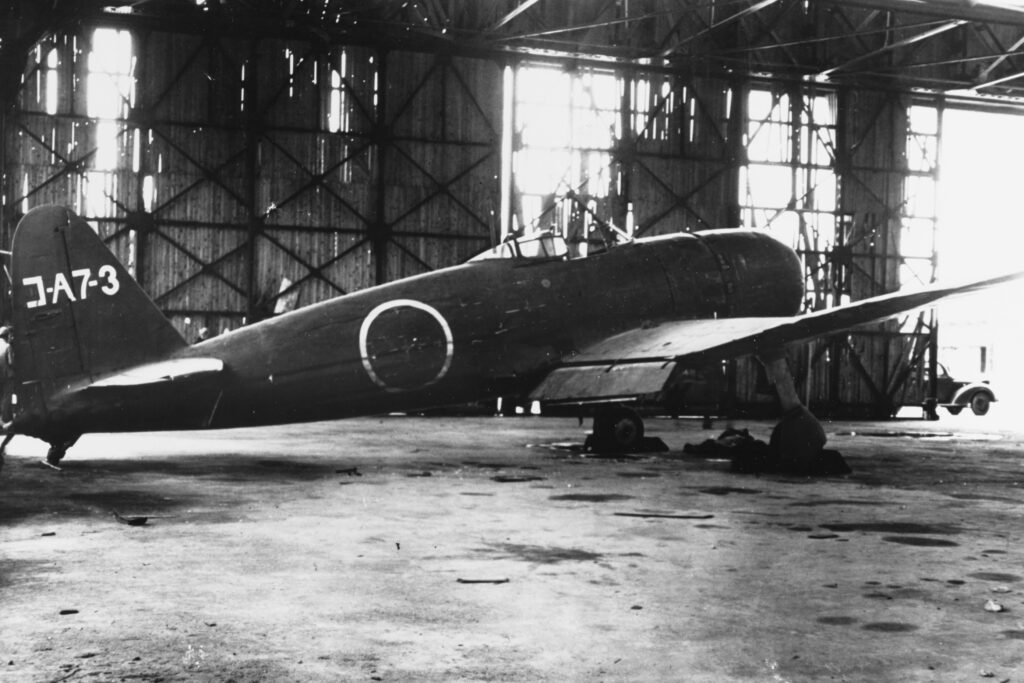
The Zero was incrementally improved throughout the war, from the A6M2, the first model to take on American fighters, to the A6M8 (only two built), intended to attack B-29s. The Zero’s excellent Nakajima-built Sakae engine was eventually upgraded by about 150 hp, but it never attained anything like the horsepower offered by the Pratt & Whitney R-2800, the P-38’s twin Allisons or the P-51’s Packard Merlin. Yes, the Zero’s power-to-weight ratio was always better than that of its U.S. opponents, but sheer horsepower allowed the Americans to loft superior firepower, substantial armor and overbuilt airframes. What the Japanese needed and never got was not a better Zero but an all-new fighter—a Japanese Hellcat. When the war ended and the Zero stood down, the U.S. was within a week or two of introducing yet a third generation of Pacific fighters in the form of the Bearcat. Imagine a novice Zero pilot forced to confront this Grumman brute.
The Zero began the Pacific War with an aura of invincibility. After Pearl Harbor, it quickly came to be viewed as some kind of mystery ship, imbued with strange powers, able to do things no other airplane could. Yet it was simply a well-engineered, straightforward aircraft optimized for maneuverability and flown against an enemy that had never credited the Japanese with the ability to design a cutting-edge fighter. Even though Claire Chennault of the Flying Tigers had sent back to the U.S. reports of the airplane’s capabilities over China, they were ignored, and American aircraft-recognition manuals didn’t even include a picture of a Zero. As aviation historian William Green wrote, the Zero“created a myth—the myth of Japanese invincibility in the air….Its successive appearance over every major battle area in the opening days of the war seemed to indicate that the Japanese possessed unlimited supplies of this remarkable fighter, and its almost mystical powers of maneuver and ability to traverse vast stretches of water fostered the acceptance of the myth of its invincibility in Allied minds.” Zeros often showed up so far from the nearest Japanese-controlled land that the Americans set out in search of the carrier from which it was assumed they’d taken off.
The Zero was designed by a team under the direction of a brilliant young aeronautical engineer, Jiro Horikoshi. Mitsubishi had the foresight to send Horikoshi to work and observe at aircraft factories in Europe and the U.S. in 1929, and he even spent several months at a Curtiss plant in New York, as an acceptance inspector for a batch of P-6 Hawk pursuit biplanes the Japanese had ordered. Horikoshi had already engineered the Mitsubishi A5M, later code-named “Claude” by the Allies. For an open-cockpit, fixed-gear fighter, the A5M displayed outstanding performance—in no small part because of its flush riveting, a production technique the Japanese would subsequently use on the Zero at a time when American airframers were just discovering its low-drag advantage. In order to fight not only the already-overmatched Chinese but also the Pacific war against the U.S. that was beginning to look inevitable, however, Japan needed something more than the Claude. The Japanese would never have attacked Pearl Harbor if they hadn’t had the Zero. At the time, in fact, some planners had misgivings that there weren’t yet enough Zeros available for the attack to succeed.
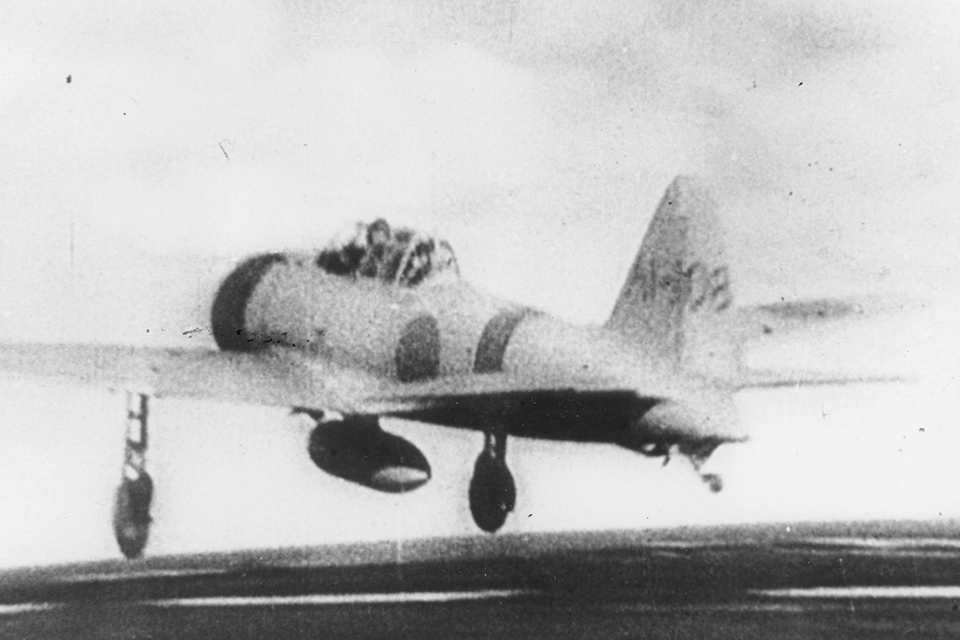
When the Japanese navy gave Mitsubishi its marching orders as Zero design began, it demanded a triple threat: an escort with the extreme range needed to accompany bombers deep into China and later to cover vast Pacific distances; a point-defense interceptor with a rapid rate of climb to hit attacking bombers before they reached their targets; and a consummate dogfighter with extreme maneuverability. (Though it’s often assumed the Japanese army air force also flew Zeros, it never did. Another Zero oddity is that though all Japanese naval aviators were carrier-qualified, many, including the famous Zero super-ace Saburo Sakai, never operated from a carrier in combat.)
The extreme-range criterion resulted in one piece of little-acknowledged pioneering for which the Zero was responsible: It was the first airplane designed from inception to carry a jettisonable external fuel tank. A Zero’s maximum fuel load, including the belly tank, typically was about 230 gallons, and this gave it a seven- or eight-hour combat endurance. Sakai set the Zero endurance record—just over 12 hours—by throttling back to 1,700 rpm and running what today we’d call “lean of peak” (maximum exhaust-gas temperature) at just 130 mph. He intentionally ran his tanks bone-dry while circling above his Formosa air base after a mission and dead-sticked in from 8,000 feet.
Another Zero innovation was its 360-degree-view cockpit canopy, second only to the British Westland Whirlwind’s bubble canopy. Though it was a multipaned greenhouse rather than a true bubble, the Zero’s glassware provided a considerably better rearward view than anything but a true open-cockpit design, and also had excellent drag-reducing properties. It could be opened in flight but not jettisoned, making parachute egress difficult. It was assumed that a Zero samurai would continue fighting to the death rather than bail out. Most Zero pilots refused to wear parachutes in any case, until they ultimately were ordered to strap them on.
It has often been said that “the engine makes the airplane,” whether it’s the Spirit of St. Louis’ Wright Whirlwind, the P-51’s Merlin or the 747’s JT9D. In the late 1930s the Japanese had developed nothing more powerful than several 800- to 1,000- hp radials with little growth potential, at a time when American, British and German manufacturers were cranking out 1,200-hp engines, with 2,000 hp visible on the horizon. So Horikoshi needed to make his new fighter super light, which he did in part by having lightening holes cut and drilled through every internal airframe part possible—a technique that racecar builders would recognize immediately. In fact, Horikoshi could be called the Colin Chapman of aircraft designers; Chapman was the Lotus designer whose mantra was “simplicate and add lightness.”
This horrified some traditional engineers, one of whom, when later asked to identify the Zero’s main weakness, complained that “it was full of holes!” Horikoshi also persuaded the navy to change its ultimate-load standards for many components he didn’t consider crucial; he designed them to “fail” but then rebound to their previous shape as soon as the load was reduced. As a result, the Zero was the fastest 1,000-hp, radial-engine fighter ever produced—but one with a number of single-point-failure locations that, if hit, could bring down the airplane.
The Zero was skinned with the lightest-gauge aluminum possible, and when the shadows were right, some photos of Zeros in flight show them seemingly clothed in crinkled tinfoil, especially in the cockpit area. British test pilot Eric Brown, who flew a captured Zero immediately after the war, even today recalls the constant noise of the oil-canning fuselage skin—“like the sound produced when one pushes on the side of a large biscuit tin.” A typical Zero loaded with full fuel and ordnance weighed about 5,500 pounds—less than a midsize Cessna twin. A fully loaded Hellcat weighed well over twice that much, and definitely wasn’t full of holes.
The single heaviest component of any airframe is the main wing spar. Horikoshi lightened the Zero’s by 30 percent by using a new zinc/aluminum alloy called Super Ultra Duralumin, which had recently been developed by Sumitomo Metals. A similar alloy was at the same time being experimented with in the U.S., and it would come to be called 7075—the most common “aircraft grade” aluminum even today. One major benefit of 7075 over the Sumitomo metal was that it was very corrosion-resistant. In many recovered Zero hulks, the main spars have largely turned to powder.
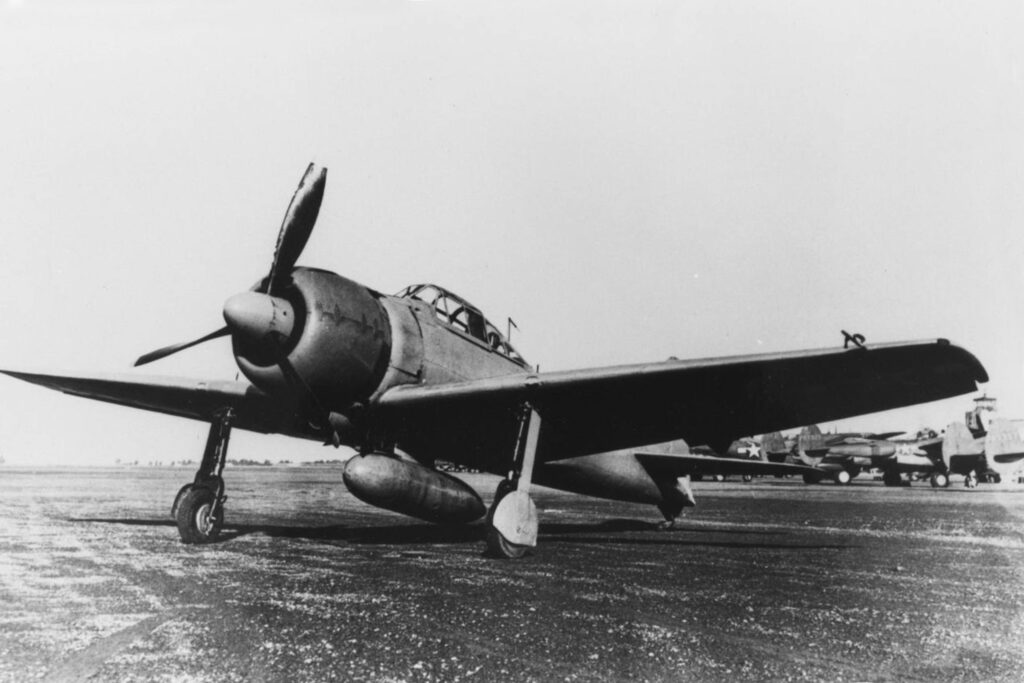
In another weight-saving measure, the Zero’s main spar was continuous, from wingtip to wingtip, and thus was an inseparable part of the fuselage center section rather than having a left and right wing, each bolted to the fuselage. This eliminated the weight of fasteners and spar brackets. Though it might seem that permanently affixed wings would make a Zero difficult to transport, Horikoshi had designed the entire tailcone and empennage to easily unbolt just aft of the cockpit. With everything removed forward of the firewall as well, the wing and cockpit became a single long but light and narrow truckload.
Horikoshi’s search for lightness led him to the oft-criticized failure to include adequate armor or self-sealing fuel tanks in the Zero design. What is forgotten, however, is that virtually no fighters at the time the Zero was introduced had such features. It remained for the Battle of Britain, in the summer of 1940, to demonstrate the need for armor and protected tanks. In any case, the Zero’s designers considered armor unnecessary because they didn’t think anybody would be able to put any rounds into the fighter. Maybe a lucky shot here and there, but not enough of a danger to compromise the design’s lightness. Little did they know what the Navy and Marines had in store for them.
Most combat units also removed their Zeros’ radios for additional weight savings, since the Japanese transceiver was of very poor quality. (How strange, since Japan quickly became the world’s microelectronics powerhouse two decades later.) This left Zero pilots unable to warn wingmen of surprise attacks, and they could coordinate their own attacks only with occasional hand signals. A typical multi-plane Zero attack was a melee of individual aerobatics, and Japanese pilots were in nearly as much danger of midairs with their mates as they were of getting shot at. As one USN pilot put it, “From the way the Zero pilots rollicked around the sky, at times it looked as though they would rather stunt than fight.”
“Yonekawa…flew upside down, waving both hands around in the cockpit,” wrote Sakai in his book Samurai.“Then he flew directly over me, under me, and went through a wide hesitation roll around my fighter. He was like a kid showing off. He finally flew on my wing and held the stick between his knees. Still grinning, he waved his lunchbox at me and started to eat.”
Zero pilots had actually preceded naval aviator John Thach’s famous “Thach Weave” by developing their own “escort weave” tactic while protecting bombers. But without fighter-to-fighter communication, it was far less effective than Thach’s independently developed cover-my-six maneuver.
The Zero’s flight controls mixed some ingenious engineering with at least one awkward feature: Its ailerons were large and powerful, which added greatly to the fighter’s low-speed maneuverability and spectacular roll rate, but they were very difficult to deflect at high speeds. American pilots soon learned to dive and turn sharply—especially to the right, which substantial prop-induced torque made particularly difficult for the Zero—when they had a Zero on their tail.
Horikoshi did an interesting job with the Zero’s elevator, however. The airplane’s speed range was broad, from low-speed maneuvering to flat-out dashes at more than 300 mph, and elevator effectiveness of course increased with speed, to the point where it could become quite touchy. So Horikoshi designed an elastic control system, with thin elevator cables that stretched a bit as speed increased and a slightly flexible elevator-control torque tube. Normally, such a setup would be anathema to an aeronautical engineer, for it encouraged an elevator to flutter as speed increased, but somehow, whether through luck or engineering talent, Horikoshi found a sweet spot where there was no danger of flutter yet elevator control forces remained constant regardless of the airspeed.
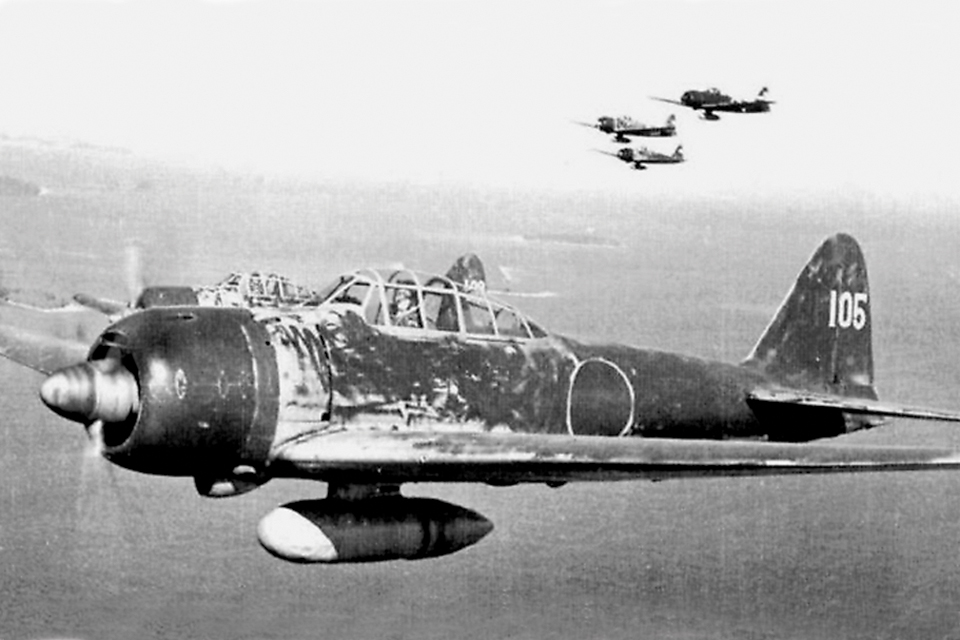
Zeros were feared in part because of their two heavy wing-mounted 20mm cannons—Swiss Oerlikons built under license by the Japanese. (Japanese hospitality: Oerlikon sent five Swiss engineers to Japan in 1938 to help set up production, and the Japanese interned them until 1945.) Horikoshi suspected that the Zero would yaw appreciably as first one and then the other cannon fired and recoiled, so he specified a fuselage longer than its optimal length, which gave the vertical stabilizer a longer moment arm and thus provided greater longitudinal stability. But the Oerlikons were still problematic. They had a low rate of fire, limited capacity (initially only 60 rounds per gun, later increased to 100) and low muzzle velocity. The latter meant that the cannon was effective for close-in fighting, where a single round into a Wildcat’s wing root or cockpit could mean a kill, but as the distance to target increased, the cannon rounds would lose energy and drop away ineffectually, like a softball thrown underhand.
A number of the Zero’s smaller components, such as instruments and engine accessories, were also license-built Bendix, Sperry, Kollsman and other designs, which would lead to later claims that the airplane was a “copy” of the Hughes H-1 Racer or the vaguely similar looking Vought V-143, but as Horikoshi later wrote, “We were trying to surpass the rest of the world’s technology, not just catch up to it.” The Zero’s single most important “U.S.” part was its Hamilton Standard-design constant-speed propeller. The Japanese had also bought a V-143 in 1937, and the Zero’s landing gear and retraction mechanism was almost certainly a copy of the Vought’s design; after all, the Zero was one of the first retractables the Japanese built.
The Zero’s two cowl-mounted 7.7mm machine guns were not particularly effective, especially against the new generation of heavy, over built U.S. fighters. At little more than half the caliber of the American .50s, they were used by many Zero pilots mainly as “pointers” for their cannons; if they saw hits from the machine guns, they toggled the cannons alive and fired them instead. Just like a World War I Spad or Fokker, the Zero’s 7.7mm receivers were in the cockpit, above the instrument panel on either side, and the pilot pulled levers to charge them. Shades of the Red Baron.
Ultimately, the Zero’s main failing was that it was designed to a 1930s paradigm: Air combat meant dogfighting, and dogfighting, at least in the days before energy management, meant a circle-chase, in one form or another, with the better airplane turning tighter than the lesser one and eventually getting into a firing position from a rear quarter. Victory was then nearly inevitable. And the Zero was the world’s tightest-turning, most maneuverable fighter. Thanks to its aerobatic ability, Zero pilots also developed a combat maneuver that initially baffled American airmen: a kind of sideways loop with square turns and side-slips out of the turns, which tightened the turn greatly.
It didn’t take long, however, for American pilots to learn that rat-racing with a Zero was a loser’s game, so they disdained tail chases that played straight into the Zero’s only air combat strength; it was neither strong, unusually fast, good in a dive nor effectively armed. Hit and run became the mantra: Attack a Zero from above, fire while diving upon it and then keep going. Convert diving energy to zooming altitude and do it again, if necessary.
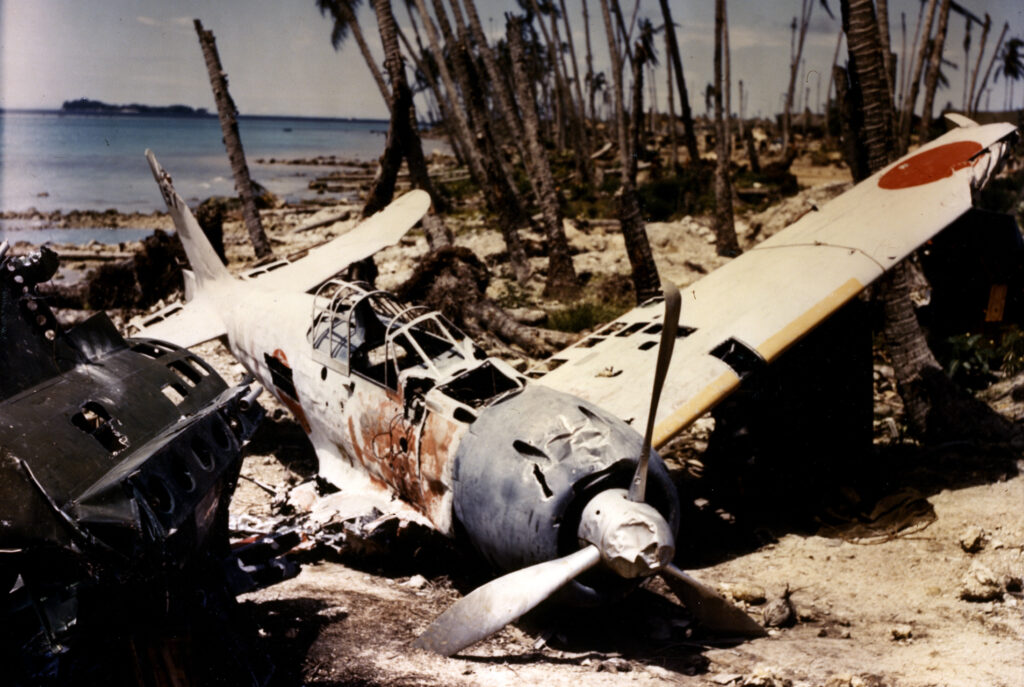
Perhaps it was inevitable that the Zero would become a myth, a legend, a paragon among fighters when it was in fact a conventional airplane with several ahead-of-its-time characteristics. It could be argued that the Zero was an excellent airplane but a lousy fighter. After flying a Zero, the highly respected Curtiss test pilot H. Lloyd Child even suggested that “a commercial version of it would appeal to a sportsman pilot after the war. Its clean lines, simplicity, lightness and ease of handling…would make this a desirable airplane for a millionaire private owner.”
If you discount the victories over poorly trained Chinese pilots flying outmoded Soviet fighters, the huge fleet of Allied aircraft destroyed while they were parked in the opening days of the war and the kills of utterly unprepared American pilots in many cases flying adequate airplanes but using the wrong tactics against the Zero, the mythic Mitsubishi comes off surprisingly poorly. It was extremely light and had numerous failure points where a very few rounds of heavy-caliber machine gun fire could do catastrophic damage. It was flammable, and its pilot was terribly vulnerable. It was not particularly fast, and in any case its high-speed handling was poor. Its controls were poorly harmonized. Its armament was a mixed bag of too-light machine guns and crude cannons. It had no useful communications equipment. Ultimately, the Zero was a bare-bones airplane—nothing extra, nothing fancy—typical of frugal Japanese designs “with very little margin for modification, designs which had little, if any, ‘stretch’ built into them,” wrote Zero expert Robert C. Mikesh.
Some say that because the Zero was the best dogfighter in the Pacific theater, perhaps the world, it was by definition the best fighter. But there’s an old saying in auto racing, “To win, you have to finish.” So praising the Zero’s maneuverability is a bit like saying a racecar is the best in the world be cause it’s the fastest, even if it can’t finish more than 10 laps of a track before having a mechanical failure and being beaten to the checkered flag by a slower car.
Unfortunately for the Japanese, the Pacific War was one race that the Zero finished last. Dead last.
For further reading, frequent contributor Stephan Wilkinson recommends: Zero, by Robert C. Mikesh; Eagles of Mitsubishi: The Story of the Zero Fighter, by Jiro Horikoshi; and Combat Legend: Mitsubishi Zero, by Robert Jackson.
Originally published in the July 2012 issue of Aviation History Magazine. To subscribe, click here.

